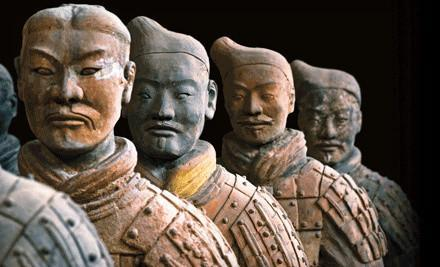
What’s So Special About the Thousands of Terracotta Warriors?
Each Warrior is Unique
One of the most extraordinary features of the terracotta warriors is that each appears to have distinct features—an incredible feat of craftsmanship and production.
Individualized Features
No two warriors are exactly alike. Each has unique facial features, hairstyles, clothing, armor, and even facial expressions, reflecting their individual roles and ranks within the army.
- Faces: The faces of the warriors are particularly striking in their diversity. They display a range of ages, ethnicities (including Han Chinese, Central Asian, and Mongolian features), and emotions. Some appear stoic and determined, while others seem to convey a sense of anxiety or even fear.
- Hairstyles: The warriors' hairstyles and headwear provide further clues about their rank and position. Some sport elaborate topknots, while others wear caps or helmets that signify their roles within the army.
- Clothing and Armor: The warriors are dressed in various types of clothing and armor, again reflecting their ranks and military specializations. Some wear simple tunics, while others are clad in heavy armor made from leather or bronze. The level of detail in the armor is remarkable, with individual scales and plates meticulously crafted.
- Facial Expressions: The subtle variations in their expressions add to the realism and individuality of the warriors, making them seem less like statues and more like a real army frozen in time.
Techniques and Production
Creating such a vast and varied army of life-sized figures required a highly organized and efficient system of production.
- Assembly Line Production: It is believed that artisans worked in specialized workshops, with each group focusing on a particular aspect of the figures, such as heads, limbs, or armor.
- Modular Construction: The figures were then assembled using a modular system, allowing for variations in pose and attire.
- Molds and Individual Touches: While molds were likely used to create the basic shapes of the warriors, artisans added individualized features by hand, ensuring that no two figures were exactly alike.
- Painting for Realism: The figures were originally brightly painted, further enhancing their realism. Traces of pigment suggest that they were adorned with vibrant colors, highlighting the details of their clothing, armor, and faces.
A Symbol of Power and Legacy
The individuality of the terracotta warriors is not just an artistic achievement but also served a symbolic purpose.
- Reflection of a Real Army: By creating a vast army of unique individuals, Qin Shi Huang, the First Emperor of China, aimed to demonstrate the power and reach of his empire. He wanted his tomb to be guarded by a replica of his real army, reflecting the diversity and strength of his forces.
- Afterlife Protection: On a deeper level, the unique features of the warriors may also reflect the belief that each soldier had a distinct soul that needed to be honored and protected in the afterlife.
The terracotta army stands as a testament to the ingenuity and artistic skill of the ancient Chinese. The fact that each warrior was crafted with such care and attention to detail speaks volumes about the importance placed upon individuality, even within a vast and regimented army. They offer a glimpse into the past, allowing us to marvel at the ambition, artistry, and beliefs of a civilization that flourished over two thousand years ago.
FAQs
Q: How many terracotta warriors are there?
A: It is estimated that there are over 8,000 terracotta warriors, along with horses and chariots, buried in the mausoleum complex.
Q: Why were they buried with the emperor?
A: The terracotta army was intended to serve as a symbolic guardian for the First Emperor in the afterlife, protecting him and accompanying him on his journey to the next world.
Q: How were the terracotta warriors discovered?
A: The warriors were discovered by accident in 1974 by farmers digging a well near the city of Xi'an, China.